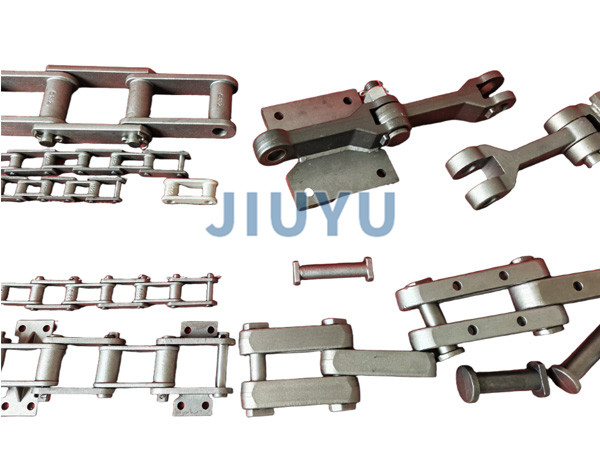
In addition to industrial gears and chains, there are many common mechanical components. Here are some other mechanical components for you:
Bearings: used to support rotating shafts or other moving parts, reduce friction and wear, and protect the smooth operation of components. According to their frictional properties, they can be divided into rolling bearings and sliding bearings. Rolling bearings have the advantages of low friction resistance, sensitive start-up, good efficiency, and easy lubrication, and are widely used in various machinery; Sliding bearings have the characteristics of high load-bearing capacity, smooth operation, low noise, and good performance, and are commonly used in high-speed, precision suitable, and heavy-duty mechanical equipment Couplings: mainly used to connect two shafts, allowing them to rotate together and transmit torque. Common couplings include rigid couplings, elastic couplings, and Anran couplings. Rigid couplings have a simple structure and transmit large torque, but require high coaxiality between the two shafts; Elastic couplings can compensate for the relative displacement of two shafts and have the functions of buffering and vibration reduction; The Anran coupling will automatically disconnect when the transmitted torque exceeds a certain value, providing protection for the equipment Clutch: Used in mechanical transmission to enable the two shafts to engage or disengage at a suitable speed when needed, in order to achieve power transmission or interruption. There are various types of clutches, such as friction clutches, electromagnetic clutches, toothed clutches, etc. Friction clutches transmit torque through friction, ensuring smooth engagement and thorough separation, and are widely used; The electromagnetic clutch uses electromagnetic force to control the engagement and disengagement of the clutch, and has the characteristics of suitable response speed and good control accuracy; The toothed clutch transmits torque through the engagement of teeth, which is large but has an impact during engagement. It is generally used in low-speed and heavy-duty situationsKey: Used to connect shafts and transmission parts on shafts, such as gears, pulleys, etc., to achieve circumferential fixation and transmit torque. Common keys include flat keys, semi-circular keys, wedge keys, and splines. The flat key structure is simple, easy to assemble and disassemble, and has the widest application; The semi-circular key can swing in the keyway of the shaft, automatically adapting to the slope of the hub keyway, and is commonly used for connecting tapered shaft ends; The upper surface of the wedge key has a slope of 1:100, which transmits torque through the wedging effect and can withstand unidirectional axial forces, but it has an impact on the centering accuracy of the components on the shaft; Splines have the advantages of high load-bearing capacity, good centering accuracy, and good guidance, and are commonly used in situations with large loads and high requirements for centering accuracy
Spring: It has functions such as storing and releasing energy, buffering and damping, and controlling motion. According to their different shapes, springs can be divided into coil springs, disc springs, ring springs, plate springs, etc. Spiral springs are easy to manufacture and widely used, and can be used for shock absorption, energy storage, and reset devices in various machinery; Disc springs have high stiffness and good buffering and vibration absorption capabilities, and are commonly used for buffering and safety protection of heavy machinery and equipment; Circular springs are mainly used in situations where large impact energy needs to be absorbed, such as cushioning devices for gun barrels; Plate springs are commonly used in suspension systems of automobiles, tractors, and other vehicles to provide cushioning and vibration reduction Sealing element: used to prevent fluid (such as oil, water, gas, etc.) leakage in mechanical equipment, as well as external dust, impurities, etc. from entering the interior of the equipment. Common seals include sealing rings, oil seals, mechanical seals, etc. Sealing rings are usually made of elastic materials such as rubber, which have good sealing performance and corrosion resistance (based on actual reports), and are widely used in various static and dynamic sealing occasions; Oil seals are mainly used for sealing rotating shafts to prevent lubricating oil leakage. They are generally composed of rubber oil seals and metal frames; Mechanical seal is a precision suitable sealing device used for rotating machinery, with advantages such as good sealing performance and long service life. It is commonly used in equipment such as pumps and compressors Fasteners: used to connect and fasten mechanical parts such as bolts, nuts, screws, washers, etc. Bolts and nuts are usually used in combination, by tightening the nut to generate a pre tightening force on the bolt, the connected parts are fastened together; The screw is directly screwed into the threaded hole of the connected part, playing a role in connection and fastening; A washer is usually placed between the nut or bolt head and the connected part to increase the contact area, reduce pressure, prevent nut loosening, etc Brake: Used to slow down, stop, or maintain a stopped state of mechanical moving parts to confirm the safe operation of mechanical equipment. There are many types of brakes, such as electromagnetic brakes, hydraulic brakes, disc brakes, drum brakes, etc. Electromagnetic brakes generate braking torque through electromagnetic force, with suitable braking speed and easy control, commonly used in various electric equipment; Hydraulic brakes use the pressure of hydraulic oil to achieve braking, and have the characteristics of large braking force and smooth braking. They are commonly used in heavy machinery equipment; Disc brakes and drum brakes are common automotive braking devices. Disc brakes have good heat dissipation performance, braking efficiency, and easy maintenance, while drum brakes have high braking torque, simple structure, and low cost


